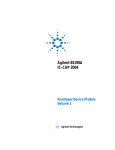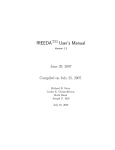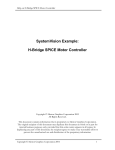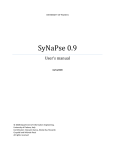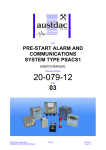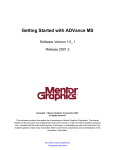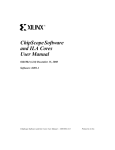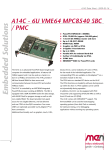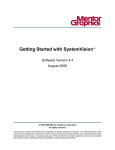Download An Abstract-Syntax-Tree based Model Compiler for Circuit Simulation
Transcript
MCAST: An Abstract-Syntax-Tree based Model Compiler for Circuit Simulation* Bo Wan, Bo P. Hu, Lili Zhou, and C. -J. Richard Shi Department of Electrical Engineering University of Washington, Seattle, WA 98195 Abstract:*This paper introduces MCAST: a Model Compiler--based on Abstract Syntax Trees---that reads compact device models described in high-level languages VHDL-AMS/VerilogAMS and automatically generates the simulator device code in C that can be directly linked with existing circuit simulators such as SPICE3. We report, for the first time, the successful implementation of industry-grade device models, including EKV, BSIM, and BSIM-SOI, in VHDL-AMS/Verilog-AMS. For a set of industry test circuits, MCAST yields the exact same simulation results as, and comparable speed to, the model code implemented manually, while existing model compilers are either limited in scope, restricted to very simple models, or orders of magnitude slower than manual implementations. 1. Introduction Circuit simulators such as SPICE [7] are the corner stone of modern VLSI design methodologies. The use of such simulators requires devices to have models built in the simulators. Unfortunately, the effort to implement a new device model into a simulator is tedious, error prone, and requires a deep understanding of underlying simulator code. As the result, it only takes 1 to 2 years for a new device model to become available in a commercial circuit simulator for circuit designers to use after it is first developed by a modeling engineer. Due to implementation considerations, a device model is only completely defined by its implementation in a simulator, which means it is either not, or hard to be, accessible and maintainable by model developers. A potential solution to this problem is a compact model device compiler. A model compiler can read compact device models described using high-level design languages such as VHDL-AMS or Verilog-AMS, and generate automatically the device simulator code that can be linked with a circuit simulator such as SPICE. Since only behavior-related device equations are needed to be described, such a model development and qualification process can take only days to weeks. Furthermore, models will be highly maintainable and reusable. Previous model compiler attempts include ADMIT [2], * This research was supported by DARPA NeoCAD Program under Grant No. N66001-01-8920 and NSF CAREER Award under Grant No. 9985507. iSMILE [3], MAST/Saber[9], ADMS [4], [5] and [6]. The principal difficulty of wide acceptance of model compilers is the performance of generated code. It is known to be 100 to 1000 times slower than manual implementation even for MOS Level 1 model and simple circuits. Further, the speed penalty increases with both the complexity of a model and the size of a circuit [10]. ADMS uses a build-in symbolic derivative calculator, and it is difficult to handle constructs like loops, if-then, subroutine call etc. To improve the performance, ADMS introduces compiler derivatives; only a limited performance enhancement can be accomplished. ADMS has not been applied to models such as BSIM. 2. MCAST Foundation and Architecture The MCAST foundation is to represent the device model written in VHDL-AMS using AST. For example, below is MOS Level 1 device model in VHDL-AMS. Vgstmp := Vg – Vs; Vdstmp := Vd – Vs; Vgdtmp := Vgstmp – Vdstmp; IF Vdstmp >= 0 THEN Forward := 1; Vds := Vdstmp; Vgs := Vgstmp; ELSE Forward := -1; Vds := - Vdstmp; Vgs := Vgdtmp; END IF; -- forward mode -- reverse mode IF Vgs <= Vth THEN -- cut off Idstmp := 0.0; ELSE IF Vgs-Vth <= Vds THEN -- saturation Idstmp := Beta * (((Vgs -Vth)**2)/2); ELSE -- triode Idstmp := Beta*((Vgs-Vth) *Vds((Vds**2)/2)); END IF; END IF; Ids := Forward * Idstmp; The AST representation is shown in Figure 1. The root of the tree is variable Ids, where leaf nodes can be constants or terminal voltages. Different from traditional AST used in computer science, we introduce a new type of Switch (SW) node to represent the widely used if-else-endif structure in VHDL-AMS. can involve potentially hundreds of parameters, variables and intermediate variables, and thousands of lines of equations. Our effort has been focused primarily on how to generate element stamping code that uses minimum amount of computations over the entire simulation run. ids * Forward SW1 Condition Tree (Vgs<Vth) SW2 -1 0.0 1 SW3 Condition Tree (Vgs-Vth<=Vds) * * - / Beta VHDL-AMS device source code VHDL-AMS parser * ** / 2.0 - 2.0 Vgs SW4 Intermedicate Format * * Vth Vds SW5 2.0 Auto-Differentiation, Auto-Element Stamping, AST construction 2.0 Optimizations Condition Tree (Vdstmp>0) - Constant Node Propogation * Vg Vgstmp Vs Node Reduction Optimization Core Node Sharing Vgdtmp ByPass -1 - Green Node Optimization - Other techniques Vdstmp Code Generation Vd Figure 1. An AST example for MOS Level 1 model. The architecture of MCAST is depicted in Figure 2. It starts from the VHDL-AMS description file of a device model. MCAST first parses the input file, checks errors and stores the device information in an intermediate format structure. Then the AST tree representation of device models and the needed derivatives are constructed, and derivatives are generated by automatic differentiation. Next, techniques are used to optimize the AST for both device equations and their derivatives. Finally, device codes that include device definition, device setup, device loading, derivative calculation and matrix element stamping, interfaces to the target simulator, truncation error checking, and convergence limiting are generated from the optimized AST. 3. AST-Driven Code Optimization The success of a model compiler depends critically on the efficiency and robustness of the generated device code, more specifically, the portion of code responsible for filling in the Jacobian matrices and the right-hand-side vectors. This so-called element stamping consists of device model evaluation, equivalent conductance and equivalent current source evaluation (derivative derivations). High fidelity device models such as BSIM C/C++ device files Figure 2. MCAST model compiler architecture. Green Node Optimization: A straightforward implementation of element stamping, as done in most existing model compilers, is to use automatic differentiation to generate the code for element stamping and incorporate the code directly for solving systems of linear equations at every nonlinear iteration of each time point. This is equivalent to evaluating the AST at every iteration. In contrast, MCAST colors the AST into three colors: green (the node needed to be evaluated only once over the entire simulation), purple (the code needed to evaluated once at each time point, and red (the code needed to be evaluated at every nonlinear iteration of each time point). Special cases of green nodes include model/instance parameter calculation and range checking. This can be substantial for models like BSIM that have hundreds of parameters. Examples of purple nodes include those calculating performances such as power consumption (multiplying currents and voltages at every time point). Red nodes include examples such as those device equations whose terminal voltages changed at each iteration. With AST, MCAST identifies automatically A. green nodes by a bottom up traversal of the AST to check on how each node depends on leaf nodes (constants, parameters, or variables), and purple nodes by a top down travel of the AST to check if a node is required at every iteration or only once at each time point. We note that exploring these computational latency manually was instrumental to the success of SPICE over general-purpose numerical simulators. MAST/Saber from Analogy [9] and ADMS [4] use specific language constructs or compiler derivatives for a model developer to indicate parameter checking or performance calculation. This still puts a huge burden on model developers, and makes the model description less readable. Further, only limited amount of optimization can be achieved. As the result, MAST/Saber has achieved a limited success for semiconductor circuits. B. Bypass: MCAST employs automatically node bypass and device bypass. MCAST uses Automatic Differentiation in the generation of the Jacobian Matrix elements associated with the device, automatic differentiation may generate large amount of intermediate dummy nodes that are just associated with the dumb operations with +0, -0, *0, *1,*-1. These nodes can be bypassed or compressed in code generation. Device bypass is a well-known method first implemented in SPICE2 [7]. It offers a reduction by allowing previously calculated results to be used again for current iteration, when the terminal voltages/currents of the device of current iteration have not changed over a limit from its previous value (often, this limit is set empirically). Otherwise, this device would have to be re-evaluated. MCAST incorporated device bypass automatically. C. Constant Propagation: Model designers often define some frequently used constants for the new device in VHDL-AMS file, such as kTq, CONSTvt0, etc in BSIM3, to make the VHDL-AMS source file easier to understand and maintain, they also may define some new constants based on those already defined constants. Thee constants are necessary for the readability of the source VHDL-AMS code. MCAST will detect those as constants and replace them by values during code generation. D. Node Reduction: If some nodes do not affect the element stamping, these nodes are redundant, and can be removed from the AST. This case often occurs at the early stage of model evaluation. E. Node Sharing: MCAST uses pattern matching to find the duplicate sub-expression trees inside an AST. Different from classical ASTs where such duplicates are always shared, MCAST AST has conditional Switch (SW) nodes, and such duplicates can only be shared if their parent nodes have the same or similar conditions. MCAST categories these duplicates based on their conditions and computational costs, and determines if they are to be shared or not. We note that green node optimization and bypass are specific to model compilers and are for the first time automated in MCAST. The other three techniques are well known in compiler theory. However, with automatic differentiation for derivative calculation used in compiler compilers, these features as in VHDL-AMS/VerilogAMS will not be able to be recognized by the C compilers from the generated C code from model compilers. 4. Experimental Results Five existing and two new device models including MOSFET level 1, level 3, BSIM3, BSIMSOI, EKV, Thermal-Electrical and Opto-Electrical device models have been implemented with MCAST, and lined with Berkeley SPICE3, and tested on thirteen benchmark circuits. For all the circuits, the simulation using the compiled models generated by MCAST from VHDLAMS yields the same results as that implemented manually in Berkeley SPICE3. As an example, the simulation results of a voltage-controlled oscillator are shown in Figure 3: the two curves match perfectly. Figure 3. The simulation results of VCO using the MCAST-compiled BSIM3 model and the manually implemented BSIM3 model. MCAST generated device codes are linked to SPICE3 source code to compare with human optimized codes (existing built-in device model codes in SPICE3). Figure 4 shows the speed comparison on benchmark circuits for MOSFET level 3 and BSIM. MCAST Level 3 model code is 10%-100% faster than the hand codes (except for one circuit), MCAST BSIM code is less than 70% slower than human optimized BSIM code. MCAST runtime 2 5. Conclusions 1.5 1 0.5 0 1 2 3 4 5 6 7 8 9 10 11 12 13 14 benchmark circuits MOSFET BSIM3 MOSFET Level 3 We presented MCAST---a model compiler that can automatically compile compact device models in highlevel modeling language VHDL-AMS into the simulator code such as SPICE. Several industry-grade device models including EKV, BSIM, and BSIM-SOI have been implemented using MCAST. Simulation of a set of industry circuits has shown that MCAST has the same accuracy and comparable performance as human optimized device code. Further, MCAST scales with the size of circuits. In addition, two mixed-technologies (thermal-electro-optical) device models were successfully implemented. Figure 4. The speed ratios of MCAST-compiled vs manually optimized device codes. We compare SPICE3 integrated with MCAST generated BSIM3 model with the best commercially available VHDL-AMS/Verilog-AMS simulator** on adders with increasing number of bits. The results are shown in Figure 5. Our model compiler with AST-driven optimization is two to three orders of magnitude faster than the commercial behavioral simulator. Furthermore, our approach scales linearly with the size of a circuit, where the cost of the commercial simulator increases exponentially. This demonstrates that the MCAST technology is especially suitable to handle large circuits. Figure 6. The speedup breakdown of various optimization techniques. Speed Comparison Simulation Time(s) 100000 References 10000 [1] 1000 100 10 1 1bit 2bit 3bit 4bit 5bit 6bit 8bit Adder Circuits BMAC-BSIM3 Commertial Behavior Model Simulator Figure 5. Speed comparison of MCAST-BSIM3 and a commercial behavior model simulator. Figure 6 shows the speedup breakdowns of different optimization techniques over thirteen benchmark circuits, in terms of device evaluation time per iteration. The overall speed up is about 4 to 5 times, where green node optimization achieves a speed up of about 3.5, and an average 50% for other techniques. ** We attempted all the existing commercial behavioral simulators, and the one used here is from a leading vendor and has the best performance comparing to other simulators. Ken Kundert, “Automatic Model Compilation – An Idea Whose Time Has Come”, The Designer’s Guide, May 2002. [2] S. Liu, K.C.Hsu, P.Subramaniam, “ADMIT-ADVICE Modeling Interface Tool”, IEEE Custom Integrated Circuits Conference, 1988 [3] A.T.Yang, and S.M.Kang, “iSMILE: A Novel Circuit Simulation Program with emphasis on New Device Model Development”, 26th Design Automation Conference, 1989 [4] Laurant Lemaitre, Colin McAndrew, and Steve Hamm, “ADMSAutomatic Device Model Synthesizer”, IEEE Custom Integrated Circuits Conference, May 2002 [5] R. V. H. Booth, “An Extensible Compact Model Description Language and Compiler”, Proc. IEEE BMAS, pp. 39-44, Oct. 2001. [6] M. Zorzi, N. Speciale, G. Masetti, “Automatic Embedding of a Ferro-electric Capacitor Model in Eldo”, Proc. IEEE BMAS, Oct. 2001 [7] L. W. Nagel, “SPICE2 – A computer program to simulate semiconductor circuits, “ Univ. of California, Berkeley, ERL Memo ERL-M520, May 1975. [8] Y. Cheng and C. Hu, MOSFET Modeling & BSIM3 User’s Guide, Kluwer Academic Publisher, 1999 [9] MAST/Saber User Manual, Analogy Inc. [10] Prof. Hal Carter, “Modeling and Simulating Semiconductor Devices Using VHDL-AMS”, BMAS 2000









